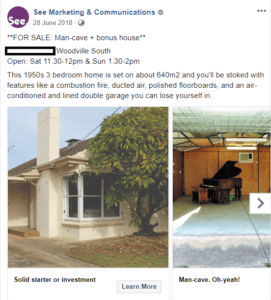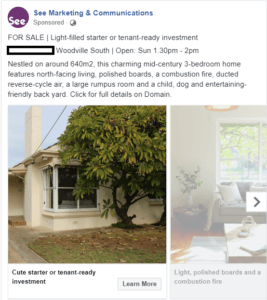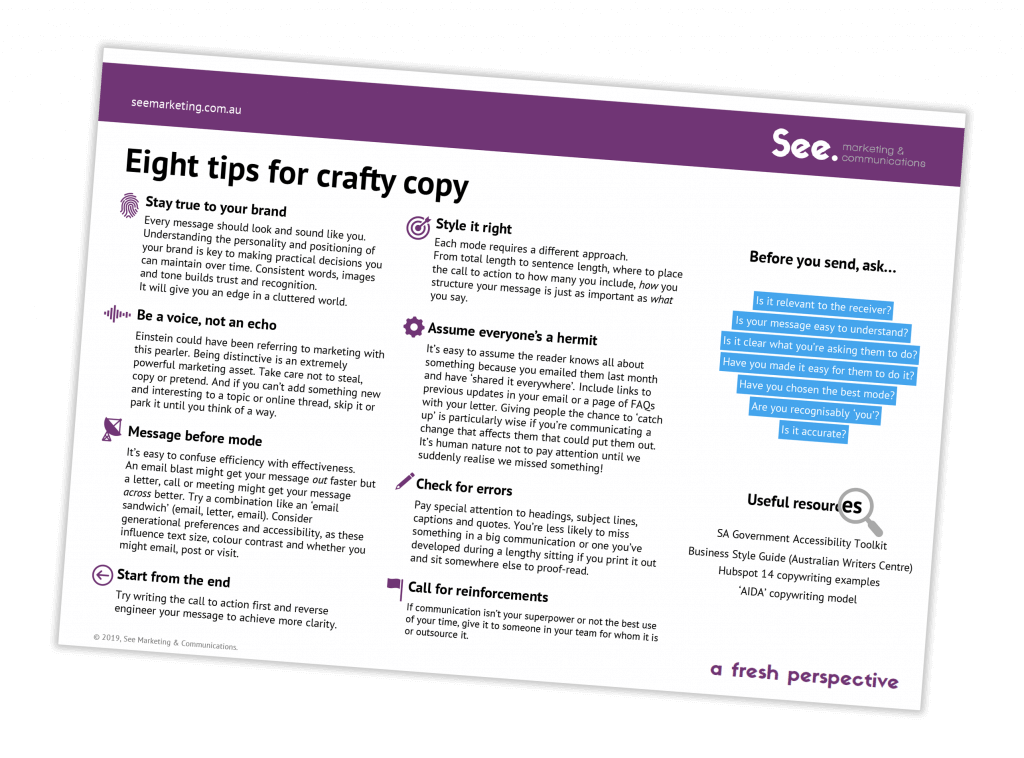The internet of things makes it easy for buyers and sellers to deal direct. So when I sold my house in mid-2018, I skipped the agent.

It’s often said that buying or selling a house is one of the biggest financial transactions many people ever make. It’s certainly true for me so far. When I put my house on the market in June 2018, I’d only ever bought one house and I’d never sold one. Given my obvious lack of property experience, conventional wisdom would point me in the direction of a real estate agent. But when the time came to choose one, I decided to look at the option of selling myself too.
I’ve never been afraid of trying new things (except being at height without a motor) so the chance to apply my marketing skills to a new industry was an interesting prospect. In the end it proved too good to pass up. In the unexpected showdown between match-fit real estate agents and disruptive technology, the more DIY option won out.
My tips for selling without an agent
I believe with the right outlook, planning and time, selling your own home is something more of us can do. I’ve shared my experiences here to help demystify the process of going it alone in the hope that it might help someone else make the decision about whether it’s right for you.
1. Mechanics: choosing the real estate property portal
Did you know private sellers can’t list on real estate websites like Domain and RealEstate.com? Neither did I until I tried to do it. Unless you plan to rely on a sign on your front frence or ads in the paper (and I wouldn’t personally), you will need an intermediary to reach a broad market online.
When you list your place on real estate websites using an intermediary, a registered real estate agent will show as the contact for your listing. This is a real person however enquiries will come direct to you unless you choose to upgrade your service (if that option is available from the platform you choose).
I compared several well-known property portals on some key criteria:
- Brand name. I ruled out brands that made it immediately obvious that it was a private sale. While I was happy to tell people I was the owner at the right time and when asked, I knew some people might feel uncomfortable with the thought of dealing direct with the owner. I didn’t want to introduce a barrier that might cause people to rule my property out before they’d even taken a look.
- Easy to use. I wanted a online portal that was easy to use and which would let me change my listing on the real estate websites in real time. I knew I’d want to use feedback from open inspections to update my listing (more on that later). I also knew the real estate learning curve would be steep enough without also having to be frustrated by a clunky website portal. Some portals let me upload quite a bit of information before I had to pay so I could get a good feel for them first.
- Optional add-ons. As a marketer, there were some things I could easily take care of myself. I saved money producing my own floorplan, taking the photos and writing the property description for the brochure. I did pay for some extras (extra open inspection signs to guide people from the main road and an SMS service that notified me of buyer enquiries) which were not expensive and definitely worth it.
In the end, I went with Property Now (this article has not been commissioned by them). I liked their product and also found their responsiveness was very good from start to finish.
2. Advertising: memorable real estate ads on a budget
While my property was listed on all of the big property sites, I also ran a social media campaign on Facebook and Instagram to create a buzz at the first open. I created a segmented campaign for women and men. In the version for women, I emphasised warmth, light and the cozy fireplace and breakfast nook. In the version for men, I built it around a quirky headline: “Man-cave with bonus house”.
There were people everywhere on the first weekend. I can’t count the number who specifically mentioned the Facebook campaign and the men who were still chuckling about the creative headline. As you can see in the chart below, my advertising approach drove a significantly higher volume of traffic to my listing on RealEstate.com compared to the shaded area representing the traffic to other properties for sale in my area at the time.



Overall, it cost less than $200 to advertise online across the active four-week campaign. I analysed the insights regularly and refined the ads along the way to emphasise and de-emphasise property features according to what I was hearing (and overhearing) on the ground. There was a definite lull in Week 3 so I gave the advert a push and a new wave of people popped up in Week 4, including the eventual buyer. It’s often said that there are always new entrants in any market but it was fascinating to watch such an obvious example of it. I also placed a print ad in a major newspaper once (Week 2, just in case) but this cost me about the same for a tiny ad as the whole online campaign, and the only response I know it drew was a call from a confused real estate agent asking if it was a private sale and once I confirmed it, asking if I needed his help to sell.
3. Support: managing potential derailments
Early in my career, I learned that a great idea isn’t enough. You also need to get the right people behind the idea if you want the experience of implementing it to be a positive one.
I knew family and friends would be concerned when I told them I planned to sell my home without an agent. So I told them that if I didn’t have a signed contract within 6 weeks, I would consider calling in the experts. I’d done my homework on sales in my area and knew this was a reasonable timeframe. Having a Plan B put my loved ones at ease and also gave me some breathing space to focus on the sale process with less risk of being derailed by the apprehension of others.
In reality, most people were really supportive and encouraging. One of my friends even came out of the woodwork with relevant experience selling and buying, and she became a useful sounding board.
4. Mindset: how I emotionally detached
After 10 very happy years living in my home, I knew successfully selling my house would require me to stop thinking of it as ‘mine’ as quickly as possible.
I decided to wait until I moved out before I put it on the market. I gave myself three weeks after I moved out to get a painter, cleaner, gardener and furniture staging company to work their magic. Yes I paid a second mortgage for a little longer, but it was absolutely the right decision for me. The savings on commissions covered the overlap financially, and I knew the disruption of preparing for open inspections every week on my business and life, would be far less if I wasn’t living there.
5. Open Inspections: a chance to listen and fine tune
Initially, I asked someone else to run the open inspections for me. A few days before my first open though, I decided it was something I could and should do myself.
On the day, as a friend put out open for inspection signs from the main road, I opened the windows and doors, brewed a fresh cup of coffee, put on the heating and misted the air lightly with a coconut and lime scented room spray. I’d chosen a time of the day when the light made the house look its best inside and out. As I stood in my front yard, freshly printed brochures in hand, I was definitely uncertain that anyone would turn up. But they did – in droves. I had some immediate low-ball offers from developers which I politely declined.
The inspections were not just a chance for potential buyers to consider the property but also a chance for me to gather feedback I could use to optimise the sales process. I also opened up at other times of the week a few times when I had at least a few potential buyers interested in taking a look. (Not living in it meant the house was always neat and tidy). While the feedback from most people was expected (price about right, cute house, wonderful light, beautiful floorboards, lovely frangipanis) others didn’t hold back about its flaws (too expensive, too small, no ensuite, ugly frangipanis). But all feedback was valuable, including the comment from the woman who said my kitchen looked much nicer in real life. This prompted me to take a new photo from a different angle and replace the image on my listing that same day.
6. Details: sale price and contract
Setting a sale price was the most daunting decision I had to make in the whole process. Like any product, I knew my house was only worth what someone would pay for it. Go too low, and I’d leave money on the table. Go too high, and it would languish on the market and also cost me.
My research started a good three months earlier. I looked at sales history and local agents did, for example did they list homes like mine as auctions or private treaties. I also looked at a report provided free by Property Now, went to inspections and commissioned a valuation through my mortgage broker. The buyer was something else I thought very carefully about. I knew it would likely be a first home owner so the timing of the Banking Royal Commission became significant. The banks had just tightened lending criteria so I expected this to result in fewer, more cautious buyers and perhaps a slower process than might otherwise have been the case.
With all this in mind, I set what I believed was a fair price: not out of reach but with a little wiggle room for negotiation. My research continued right up to the sale. As people left the open inspection, I asked about other properties they were looking at and went to those opens to compare my home. I also took on board some advice I sought from the Property Now team and the unsolicited opinions of a few enterprising real estate agents who contacted me to let me know they could help if I didn’t have any luck myself.
Setting what I believed to be a realistic sale price and conditions – and being emotionally detached – made it quite easy to quickly assess the offers that came my way.
Something I’d definitely do differently is to pay for the searches before the house is listed. Doing this after receiving the offer I accepted delayed the signing of the contract by several weeks. It was the most nerve-wracking time of the whole process. I was lucky the delay didn’t scare off my buyer and that he didn’t find something else he liked better while he was waiting.
Final thoughts

Selling my own house soaked up more of my time than I imagine it would have done if I’d used a real estate agent. But I liked the personal aspect of dealing with potential buyers and I would have been anxious in different ways if I was removed from the process.
Could an agent have sold it for more? Maybe. I’ll never know. But I was happy with the sale price and happy to manage more of the practicalities myself. The risk that someone with more experience could have sold it faster / for more / with less fuss on my part was one that I was comfortable taking. And I’d have never had the experience of chasing the neighbour’s cat out of the open house during an inspection as a comedic highlight if I hadn’t sold it myself.
A few weeks ago, I drove past my old house for the first time. There were unfamiliar cars in the driveway and sadly the frangipani trees loved by both me and my neighbour’s cat, were gone. The man-cave with bonus house belongs to someone else now. I’m busy making memories in my bright shiny new home.



